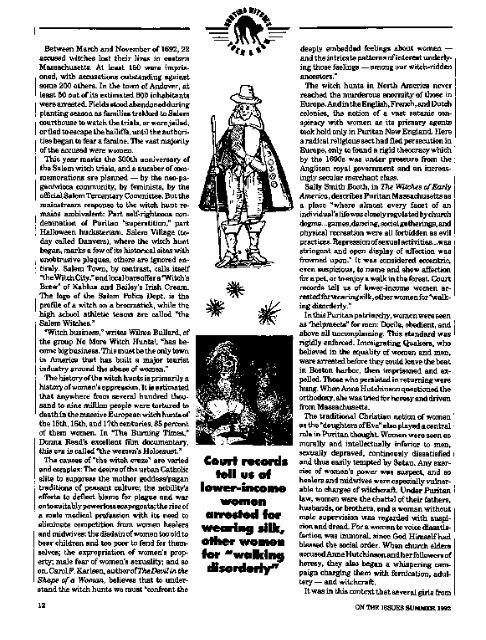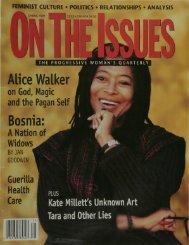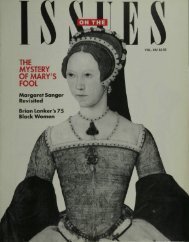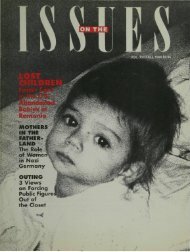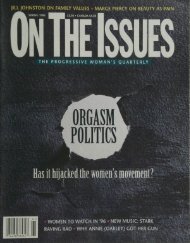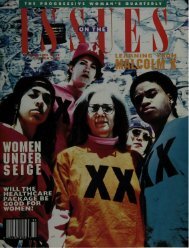300 Years & Counting 1H KILLS - On The Issues Magazine
300 Years & Counting 1H KILLS - On The Issues Magazine
300 Years & Counting 1H KILLS - On The Issues Magazine
You also want an ePaper? Increase the reach of your titles
YUMPU automatically turns print PDFs into web optimized ePapers that Google loves.
Between March and November of 1692, 22accused witches lost their lives in easternMassachusetts. At least 150 were imprisoned,with accusations outstanding againstsome 200 others. In the town of Andover, atleast 50 out of its estimated 600 inhabitantswere arrested. Fields stood abandoned duringplanting season as families trekked to Salemcourthouse to watch the trials, or were jailed,or fled to escape the bailiffs, until the authoritiesbegan to fear a famine. <strong>The</strong> vast majorityof the accused were women.This year marks the <strong>300</strong>th anniversary ofthe Salem witch trials, and a number of commemorationsare planned — by the neo-pagan/wiccacommunity, by feminists, by theofficial Salem Tercentary Committee. But themainstream response to the witch hunt remainsambivalent: Part self-righteous condemnationof Puritan "superstition," partHalloween hucksterism. Salem Village (todaycalled Danvers), where the witch huntbegan, marks a few of its historical sites withunobtrusive plaques, others are ignored entirely.Salem Town, by contrast, calls itself"the Witch City," and local bars offer a "Witch'sBrew" of Kahlua and Bailey's Irish Cream.<strong>The</strong> logo of the Salem Police Dept. is theprofile of a witch on a broomstick, while thehigh school athletic teams are called "theSalem Witches.""Witch business," writes Wilma Bullard, ofthe group No More Witch Hunts!, "has becomebig business. This must be the only townin America that has built a major touristindustry around the abuse of women."<strong>The</strong> history of the witch hunts is primarily ahistory of women's oppression. It is estimatedthat anywhere from several hundred thousandto nine million people were tortured todeath in the massive European witch hunts ofthe 15th, 16th, and 17th centuries, 85 percentof them women. In "<strong>The</strong> Burning Times,"Donna Read's excellent film documentary,this era is called "the women's Holocaust."<strong>The</strong> causes of "the witch craze" are variedand complex: <strong>The</strong> desire of the urban Catholicelite to suppress the mother goddess/pagantraditions of peasant culture; the nobility'sefforts to deflect blame for plague and waronto suitably powerless scapegoats; the riseofa male medical profession with its need toeliminate competition from women healersand midwives; the disdain of women too old tobear children and too poor to fend for themselves;the expropriation of women's property;male fear of women's sexuality; and soon. Carol F. Karlsen, author o£<strong>The</strong> Devil in theShape of a Woman, believes that to understandthe witch hunts we must "confront the12Court recordstell us oflower-incomewomenarrested forwearing silk,other womenfor "walkingdisorderly"deeply embedded feelings about women —and the intricate patterns of interest underlyingthose feelings — among our witch-riddenancestors."<strong>The</strong> witch hunts in North America neverreached the murderous enormity of those inEurope. And in the English, French, and Dutchcolonies, the notion of a vast satanic conspiracywith women as its primary agentstook hold only in Puritan New England. Herea radical religious sect had fled persecution inEurope, only to found a rigid theocracy whichby the 1690s was under pressure from theAnglican royal government and an increasinglysecular merchant class.Sally Smith Booth, in <strong>The</strong> Witches of EarlyAmerica, describes Puritan Massachusetts asa place "where almost every facet of anindividual's life was closely regulated by churchdogma., .games, dancing, social gatherings, andphysical recreation were all forbidden as evilpractices. Repression of sexual activities...wasstringent and open display of affection wasfrowned upon." It was considered eccentric,even suspicious, to name and show affectionfor a pet, or to enjoy a walk in the forest. Courtrecords tell us of lower-income women arrestedfor wearing silk, other women for "walkingdisorderly."In this Puritan patriarchy, women were seenas "helpmeets" for men: Docile, obedient, andabove all uncomplaining. This standard wasrigidly enforced. Immigrating Quakers, whobelieved in the equality of women and men,were arrested before they could leave the boatin Boston harbor, then imprisoned and expelled.Those who persisted in returning werehung. When Anne Hutchinson questioned theorthodoxy, she was tried for heresy and drivenfrom Massachusetts.<strong>The</strong> traditional Christian notion of womenas the "daughters of Eve" also played a centralrole in Puritan thought. Women were seen asmorally and intellectually inferior to men,sexually depraved, continously dissatisfiedand thus easily tempted by Satan. Any exerciseof women's power was suspect, and sohealers and midwives were especially vulnerableto charges of witchcraft. Under Puritanlaw, women were the chattel of their fathers,husbands, or brothers, and a woman withoutmale supervision was regarded with suspicionand dread. For a woman to voice dissatisfactionwas immoral, since God Himself hadblessed the social order. When church eldersaccused Anne Hutchinson and her followers ofheresy, they also began a whispering campaigncharging them with fornication, adultery— and witchcraft.It was in this context that several girls fromON THE ISSUES SUMMER 1992


